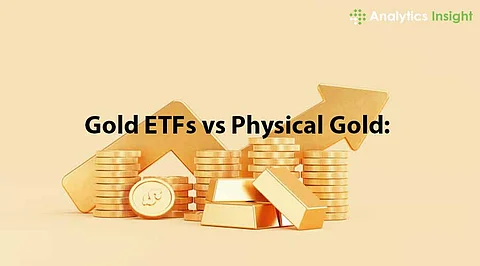

In 2025, gold investment in India is booming, with investors weighing physical gold’s tradition against gold ETFs' liquidity, cost-efficiency, and ease.
Gold has solidified its position as a key asset in investment portfolios, with India experiencing particularly strong demand driven by cultural traditions and economic dynamics. As gold prices soar beyond $3,000 per ounce, investors are presented with fresh opportunities to capitalize on this precious metal.
The decision between physical gold and gold Exchange-Traded Funds (ETFs) has become increasingly significant. Each investment avenue offers distinct benefits and considerations. Understanding these differences is crucial for making secure financial choices in a rapidly evolving market.
Physical gold means any form of the precious metal that can be touched - jewellery, coins, and bars. With about 25,000 tonnes of gold held in some form by households in India, gold enjoys both cultural and financial significance. Traditionally, it has circulated as a repository of wealth, a hedge against inflation, and a symbol of prosperity.
However, owning physical gold comes with challenges. The foremost is storage and security, which can entail renting lockers and safes. Besides, there are making charges, purity issues, and possible illiquidity for selling, to name a few.
These funds invest in gold and are traded on stock exchanges like any other stock, but represent ownership in actual gold assets, fund ownership in traditional gold stock-pool investment, for which physical storage is unnecessary. Usually, every unit of a gold ETF usually equals one gram of pure gold.
As the investment in gold ETFs, there are a number of benefits:
Liquidity: Buy and sell easily on the stock exchanges.
Transparency: Prices are for real-time.
Cost-Efficiency: Has much lower expense ratios than physical gold storage and insurance costs.
In the first quarter of 2025, gold ETFs in India saw their strongest demand in three \years, with holdings increasing significantly, indicating a shift towards digital gold investments.
It has been observed that, regarding returns, both have performed more or less the same over longer time frames. Physical Gold delivered a CAGR of about 12% over 10 years, while well-understood Gold ETFs have achieved around 10-10.5%.
Gold ETF annualized returns, achieved around 21 percent, against which it is going to become a promising investment avenue in the coming years.
Tax treatment is an essential consideration in making investment decisions. Both physical gold and gold ETFs in India are taxed under the capital gains tax. However, gold ETFs are usually considered more tax-efficient owing to indexation benefits on holding for more than three years, which would provide a better case for lowering tax liabilities when compared to physical gold.
The choice between physical gold and gold ETFs will depend on various preferences and the individual investor's objectives.
The physical entity or Physical Gold: These would generally be suited to those who see value in tangible assets, cultural significance, and a long-term proposition with zero or limited trading.
Gold ETFs: These suit the investor who values liquidity and low-cost trading through digital platforms.
For novices to gold investment, gold ETFs provide a tangible solution for those seeking an effortless investment alternative. They remove storage, purity, and security hassles, providing a simple investment experience.
Both physical gold and gold ETFs offer compelling investment opportunities, each catering to distinct financial goals and preferences. While physical gold carries cultural significance and is a reliable store of value, ETFs offer liquidity, ease of trading, and cost efficiency.
With gold prices surpassing $3,000 per ounce and ETFs delivering strong returns, investors must weigh tradition against modern investment strategies. Ultimately, the smarter choice in 2025 will depend on an individual's risk appetite, investment horizon, and need for flexibility in an evolving financial landscape.
